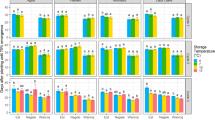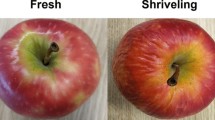Abstract
Sprouting of potatoes during storage, due to tuber dormancy release, is associated with weight loss and softening. Sprout-preventing chemicals, such as chlorpropham (CIPC), can negatively impact the environment and human health. Monthly thermal fogging with mint (Mentha spicata L.) essential oil (MEO) inhibited sprouting in eight potato cultivars during large-volume 6-month storage: the tubers remained firm with 38% lower weight loss after 140 days of storage. The sprout-inhibitory action may be nullified: treated tubers washed with water resumed sprouting within days, with reduced apical dominance. MEO application caused local necrosis of the bud meristem, and a few weeks later, axillary bud (AX) growth was induced in the same sprouting eye. MEO components analysis showed that 73% of its content is the monoterpene R-carvone. Tubers treated with synthetic R-carvone in equivalent dose, 4.5 μl l−1, showed an inhibitory effect similar to that of MEO. Surprisingly, 0.5 μl l−1 of MEO or synthetic R-carvone catalyzed AX sprouting in the tuber. To the best of our knowledge, this is the first report of an essential oil vapor inducing early sprouting of potato tubers. R-carvone caused visible damage to the meristem membrane at sprout-inhibiting, but not sprout-inducing doses, suggesting different underlying mechanisms. After 5 days’ exposure to R-carvone, its derivatives transcarveol and neo-dihydrocarveol were found in buds of tubers treated with the inhibitory dose, suggesting biodegradation. These experiments demonstrate the potential of MEO vapor as an environmentally friendly alternative to CIPC in stored potatoes and as a research tool for the control of sprouting in plants.





Similar content being viewed by others
Abbreviations
- AX:
-
Axillary bud
- CIPC:
-
Isopropyl N-(3-chlorophenyl) carbamate
- LRI:
-
Linear retention index
- MEO:
-
Mint essential oil
References
Adams RP (2001) Identification of essential oil components by gas chromatography/quadrupole mass spectroscopy. Allured Publ. Co., Carol Stream
Afek U, Orenstein J, Nuriel E (2000) Using HPP (hydrogen peroxide plus) to inhibit potato sprouting during storage. Am J Potato Res 77:63–65
Alexopoulos AA, Aivalakis G, Akoumianakis KA, Passam HC (2009) Bromoethane induces dormancy breakage and metabolic changes in tubers derived from true potato seed. Postharvest Biol Technol 54:165–171
Asplund RO (1968) Monoterpenes: relationship between structure and inhibition of germination. Phytochemistry 7:1995–1997
Bajji M, M’Hamdi M, Gastiny F, Rojas-Beltran J, du Jardin P (2007) Catalase inhibition accelerates dormancy release and sprouting in potato (Solanum tuberosum L.) tubers. Biotechnol Agron Soc Environ 11:121–131
Beveridge J, Dalziel J, Duncan H (1981) The assessment of some volatile organic compounds as sprout suppressants for ware and seed potatoes. Potato Res 24:61–76
Bolte S, Brown S, Satiat-Jeunemaitre B (2004) The N-myristoylated Rab-GTPase m-Rabmc is involved in post-Golgi trafficking events to the lytic vacuole in plant cells. J Cell Sci 117:943–954
Campbell M, Segear E, Beers L, Knauber D, Suttle J (2008) Dormancy in potato tuber meristems: chemically induced cessation in dormancy matches the natural process based on transcript profiles. Funct Integr Genomics 8:317–328
Coffin RH, Yada RY, Parkin KL, Grodzinski B, Stanley DW (1987) Effect of low temperature storage on sugar concentrations and chip color of certain processing potato cultivars and selections. J Food Sci 52:639–645
Coleman W (1987) Dormancy release in potato tubers: a review. Am J Potato Res 64:57–68
Conte E, Imbroglini G, Bertolini P, Camoni I (1995) Presence of sprout inhibitor residues in potatoes in relation to application techniques. J Agric Food Chem 43:2985–2987
Daniels-Lake BJ, Prange RK, Kalt W, Liew CL, Walsh J, Dean P, Coffin R (1996) The effects of ozone and 1,8-cineole on sprouting, fry color and sugars of stored Russet Burbank potatoes. Am Potato J 73:469–481
de Carvalho C, da Fonseca MMR (2006) Carvone: why and how should one bother to produce this terpene. Food Chem 95:413–422
Dudai N, Larkov O, Putievsky E, Lerner HR, Ravid U, Lewinsohn E, Mayer AM (2000) Biotransformation of constituents of essential oils by germinating wheat seed. Phytochemistry 55:375–382
Elmastas M, Dermirtas I, Isildak O, Aboul-Enein HY (2006) Antioxidant activity of S-carvone isolated from spearmint (Mentha spicata L. Fam Lamiaceae). J Liq Chromatogr Relat Technol 29:1465–1475
Eshel D, Orenstein J, Hazanovsky M, Tsror L (2008) Control of sprouting and tuber-borne diseases of stored potato by environment-friendly method. Acta Hortic 830:363–368
Fernie AR, Willmitzer L (2001) Molecular and biochemical triggers of potato tuber development. Plant Physiol 127:1459–1465
Fischer NH (1986) The function of mono and sesquiterpenes as plant germination and growth regulators. In: Putnam AR, Taug SC (eds) The science of allelopathy. Wiley, New York, pp 203–218
Hartmans KJ, Diepenhorst P, Bakker W, Gorris LGM (1995) The use of carvone in agriculture: sprout suppression of potatoes and antifungal activity against potato tuber and other plant diseases. Ind Crops Prod 4:3–13
Kamenetsky R (1994) Life cycle, flower initiation, and propagation of the desert geophytes Allium Rothii. Int J Plant Sci 155:597–605
Lang GA, Early JD, Martin GC, Darnell RL (1987) Endo, para-and ecodormancy: physiological terminology and classification for dormancy research. HortScience 22:371–377
Larkov O, Matasyoh JC, Dudai N, Lewinsohn E, Mayer AA, Ravid U (2007) Distribution of piperitone oxide stereoisomers in Mentha and Micromeria species and their chemical syntheses. Flavour Fragr J 22:328–333
Law RD, Suttle JC (2003) Transient decreases in methylation at 5-CCGG-3 sequences in potato (Solanum tuberosum L.) meristem DNA during progression of tubers through dormancy precede the resumption of sprout growth. Plant Mol Biol 51:437–447
Leitereg TJ, Guadagni DG, Harris J, Mon TR, Teranishi R (1971) Chemical and sensory data supporting the difference between the odors of the enantiomeric carvones. J Agric Food Chem 19:785–787
Lewinsohn E, Gijzen M (2009) Phytochemical diversity: the sounds of silent metabolism. Plant Sci 176:161–169
Lorber P, Muller WH (1976) Volatile growth inhibitors produced by Salvia leucophylla: effects on seedling root tip ultrastructure. Am J Bot 63:196–200
Meigh DF (1969) Suppression of sprouting in stored potatoes by volatile organic compounds. J Sci Food Agric 20:159–164
Northcott D, Nowak J (1988) Effects of hydrogen cyanamide on seed potato. Potato Res 31:95–103
Nurit F, Melo EG, Ravanel P, Tissut M (1989) Specific inhibition of mitosis in cell suspension cultures by a N-phenylcarbamate series. Pestic Biochem Physiol (UK) 35:203–210
Oosterhaven K, Poolman B, Smid EJ (1995) S-carvone as a natural potato sprout inhibiting, fungistatic and bacteristatic compound. Ind Crops Prod 4:23–31
Prange RK, Kalt W, Daniels-Lake BJ, Liew CL, Page RT, Walsh JR, Dean P, Coffin R (1998) Using ethylene as a sprout control agent in stored ‘Russet Burbank’ potatoes. J Am Soc Hortic Sci 123:463–469
Prat S, Frommer WB, Hofgen R, Keil M, Kossmann J, Koster-Topfer M, Liu XJ, Muller B, Pena-Cortes H, Rocha-Sosa M (1990) Gene expression during tuber development in potato plants. FEBS Lett 268:334–338
Reynolds T (1987) Comparative effects of alicyclic compounds and quinones on inhibition of lettuce fruit germination. Ann Bot 60:215–223
Reynolds T (1989) Comparative effects of heterocyclic compounds on inhibition of lettuce fruit germination. J Exp Bot 40:391–404
Rosin FM, Hart JK, Van Onckelen H, Hannapel DJ (2003) Suppression of a vegetative MADS box gene of potato activates axillary meristem development. Plant Physiol 131:1613–1622
Schmitz G, Theres K (1999) Genetic control of branching in Arabidopsis and tomato. Curr Opin Plant Biol 2:51–55
Shimizu-Sato S, Mori H (2001) Control of outgrowth and dormancy in axillary buds. Plant Physiol 127:1405–1413
Sorce C, Lorenzi R, Parisi B, Ranalli P (2005) Physiological mechanisms involved in potato (Solanum tuberosum) tuber dormancy and the control of sprouting by chemical suppressants. Acta Hortic (ISHS) 684:177–186
Sussex IM (1955) Morphogenesis in Solanum tuberosum L.: experimental investigation of leaf dorsiventrality and orientation in the juvenile shoot. Phytomorphology 5:286–300
Sussex IM, Kerk NM (2001) The evolution of plant architecture. Curr Opin Plant Biol 4:33–37
Turnbull CGN, Hanke DE (1985) The control of bud dormancy in potato tubers. Planta 165:359–365
Vaughn S, Spencer G (1993) Naturally-occurring aromatic compounds inhibit potato tuber sprouting. Am J Potato Res 70:527–533
Visser RGF, Vreugdenhil D, Hendriks T, Jacobsen E (1994) Gene expression and carbohydrate content during stolon to tuber transition in potatoes (Solanum tuberosum). Physiol Plant 90:285–292
Wiltshire JJJ, Cobb AH (1996) A review of the physiology of potato tuber dormancy. Ann Appl Biol 129:553–569
Author information
Authors and Affiliations
Corresponding author
Rights and permissions
About this article
Cite this article
Teper-Bamnolker, P., Dudai, N., Fischer, R. et al. Mint essential oil can induce or inhibit potato sprouting by differential alteration of apical meristem. Planta 232, 179–186 (2010). https://doi.org/10.1007/s00425-010-1154-5
Received:
Accepted:
Published:
Issue Date:
DOI: https://doi.org/10.1007/s00425-010-1154-5




